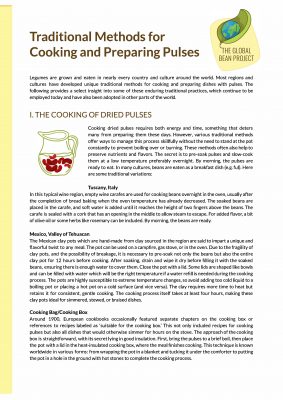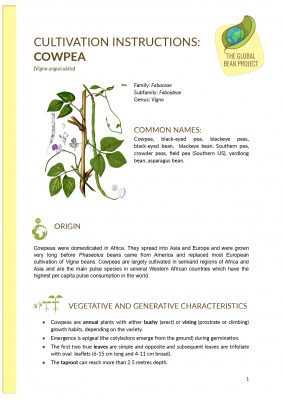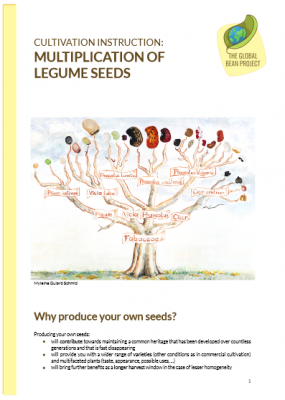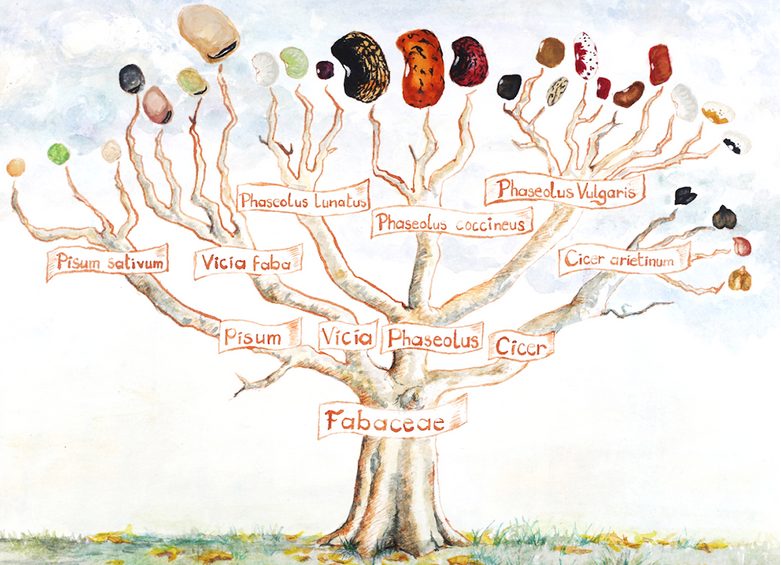
Why produce your own seeds?
Producing your own seeds:
- will contribute towards maintaining a common heritage that has been developed over countless generations and that is fast disappearing
- will provide you with a wider range of varieties and a diversity of plant characteristics (taste, appearance, possible uses, …)
- will bring further benefits such as a longer harvest window when the varieties are more diverse
- will give you greater autonomy and enable you to make your own selection of plants
- will enable the plants to adapt to your local conditions over time and to become more resistant to changing local constraints
- is an act of civil disobedience against increasingly restrictive laws that enable the big seed companies to gain total control over this source of life.
Beans
Beans are annual plants of the Fabaceae family. There are several species of beans, the most common of which are:
- Phaseolus vulgaris, which includes different kinds such as dwarf beans, semi-climbing beans and climbing beans. These two types of crops include beans grown for their pods such as green beans or for their seeds, eaten fresh or dried.
- Phaseolus coccineus or runner beans which are mostly climbing beans. They have very beautiful red or white flowers and are suited to temperatures below 25°C in order to set pods.
You can distinguish between both these two species thanks to the pods. Phaseolus coccineus has thicker pods. Those of Phaseolus vulgaris are thinner and smoother.
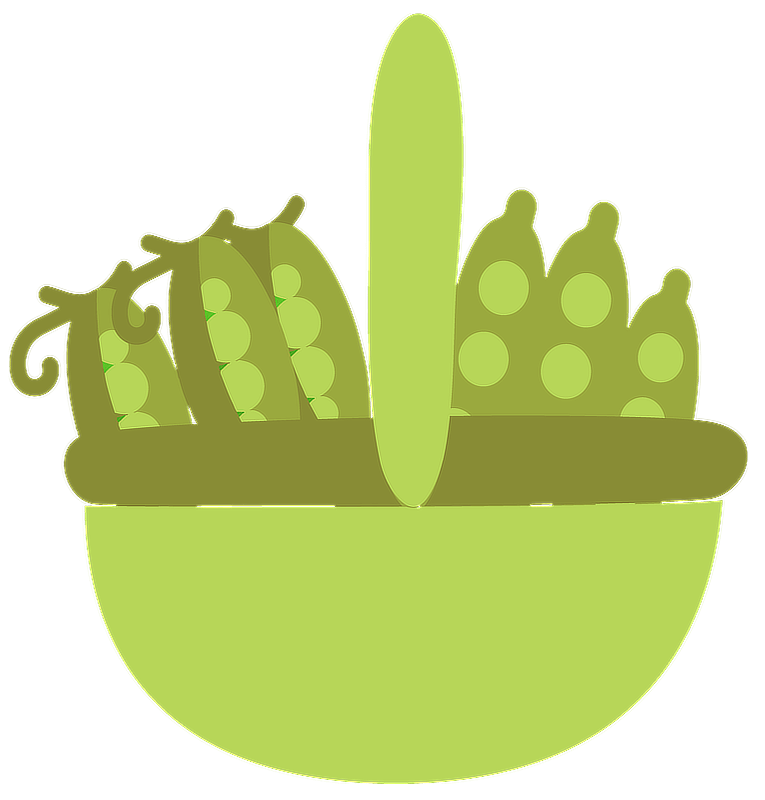
POLLINATION
- Phaseolus vulgaris: The flowers are hermaphrodite and self-fertilising (autogamous), meaning they have male and female organs in the same flower and the fertilisation often already takes place within the flower. Insects may nonetheless cause cross-pollination between different varieties. This risk is more or less great depending on the variety. To reduce this risk, if it is crucial for you to avoid outcrosses, you should leave a distance of at least 5 or 10 meters between two varieties of beans. Other flowering plants between the varieties will further decrease the risk of cross-pollination. To preserve maximum varietal purity despite a lack of space, you can cover each Phaseolus vulgaris variety with a mosquito net. Be careful to place the net before flowering starts to avoid any cross-pollination.
- Phaseolus coccineus: The flowers are hermaphrodite and cross-pollinating (allogamous), meaning they require insects such as bees and bumblebees for the pollination. Beans with cream-colored flowers can self-pollinate. To avoid cross-pollination between two varieties of Phaseolus coccineus keep a distance of 500 meters. This distance can be reduced to 150 meters if there is a natural barrier such as a hedge. Cross-pollination between a coccineus climbing bean and a vulgaris climbing bean occurs only rarely. To ensure the varietal purity you can leave a distance of 300m to vulgaris climbing beans and a 50m distance if it is a vulgaris dwarf bean.
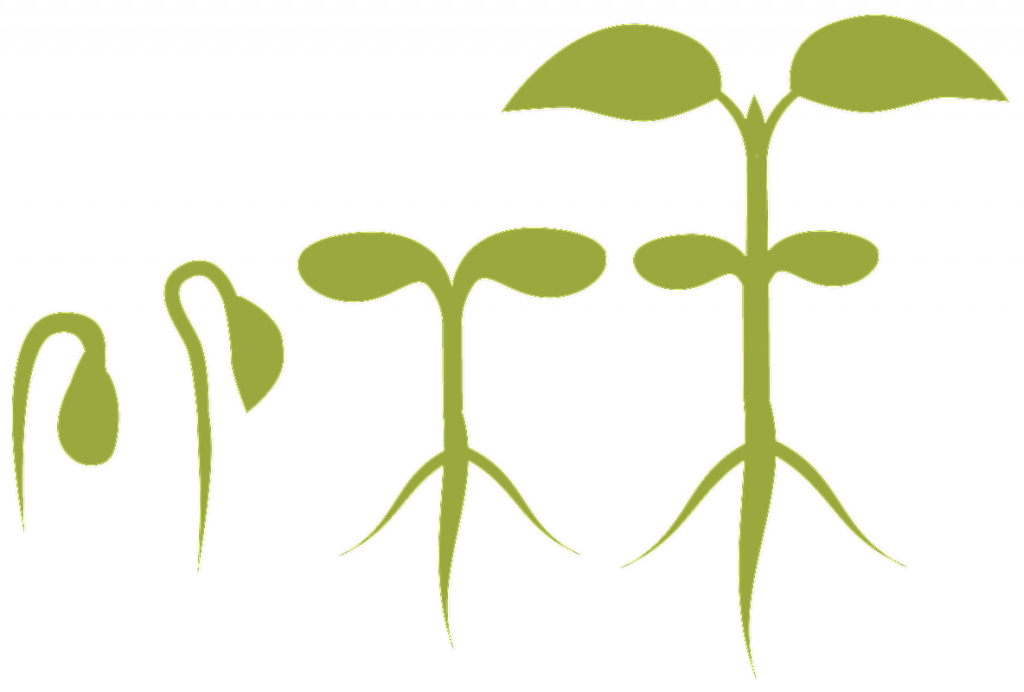
LIFE CYCLE
- The technique for growing beans for seeds is the same as for growing them for food. They require warm soil for sowing.
- For the green bean, it is better to divide the crop into two sections: one for food and one for seed production. Harvesting for food is done throughout the season, whilst harvesting the seeds must be done only when all pods are mature. If you only keep the pods that mature at the end of the season, you will end up with a late-season variety.
- To harvest the seeds, wait until the pods have dried. For certain varieties, including climbing beans, harvesting time can be spread out. For certain species of dwarf beans, all pods dry at the same time, meaning that the seed harvest can be done in one go by cutting all of the plants.
- If the weather is damp and the seed-bearing plants are not completely dry, you can put them to dry in a well ventilated shed. It is important to protect them from insects with a net. Leave the seeds to dry for two or three weeks after harvest. To check they are ready, bite one slightly: if this leaves no mark, drying is complete.

EXTRACTING, SORTING, STORING
- For small quantities, shelling can be done by hand. For larger quantities, you can beat the pods with a stick. You can also walk on them.
- Once they have been beaten, you can sieve the beans. The sieve will retain the beans and larger waste which can easily be removed. To get rid of the remaining smaller waste, you will need to winnow or ventilate what is left. You can ventilate either by blowing on it yourself or by using a ventilator or small compressor.
- Remove those that are of a different type, they are a sign of cross-pollination. Remove also damaged or badly formed beans and those infested by weevils. The bean weevil (Acanthocelides obtectus) is a small insect that lays its eggs inside the pod on the plant. An easy way to get rid of them is to leave the seeds in the freezer for at least a week. The beans must be properly dry before freezing and be stored in airtight packaging.
- Always write the name of the species and the variety, as well as the year of harvest on a label and put it inside the bag with the seeds. Writing on the outside may rub off.
- Putting the bag in the freezer for a few days kills the larvae of parasites. Bean seeds germinate very well for three to five years. To prolong their germination capacity, keep them in a cool place (below 6 degrees) or in the freezer.

FURTHER INFORMATION
Instruction film: https://www.diyseeds.org/en/film/bean/
Faba Beans
Broad beans are from the Fabaceae family and the Vicia faba species. They are annual plants grown for their seeds that can be of different colours and sizes. They are also grown for their young shoots. There are different types of broad beans, some for human consumption and other for animal forage.

POLLINATION
The flowers of broad beans are hermaphrodite and self-fertilising, meaning that the male and female organs are on the same flower and are compatible (autogamous). There is however a risk of cross-pollination between different varieties by insects. The frequency of crosses varies from 5 to 60% depending on varieties, the environment and whether there are natural barriers. To avoid cross-pollination, grow different varieties 1km apart. This distance can be reduced to a few hundred meters if there is a natural barrier, such as a hedge. To ensure the purity of a variety, you can cover the plants for seed production with a net. In this case you should put it in place before flowering begins.

LIFE CYCLE
- Broad beans grown for seeds are cultivated in the same way as those for food.
- This plant does not like high temperatures as this stops pollination and reduces production.
- Sow broad beans either at the end of autumn in fair climates or at the end of winter, when the soil is ready.
- To ensure good genetic diversity, it is necessary to grow at least 10 broad bean plants for seeds. While the plants are developing, choose the most beautiful, healthy and productive plants for seed production.
- The length of the harvest period is also a selection criteria. You should reserve a part of the crop for seed production and not harvest any beans before full maturity. Avoid picking the first pods for consumption and keeping the last ones for seeds, as seeds from the first pods will keep the early characteristics of the variety.
- If the weather is wet, harvest the seeds before they are fully mature and leave them to dry in a dry and well-ventilated area.
- Most of the time, the plants can be left standing to dry until the pods become black.
- The best seeds are in the first pods to be formed, at the base of the plant.
- To make sure that the seeds are dry, bite one gently. If this leaves no mark, then they are fully dry.

EXTRACTING, SORTING, STORING
- You can either extract pod by pod or drive over them with a vehicle. In this case, make sure to place the harvest on soft ground so as to not damage the seeds.
- To sort the beans, remove those that are of a different type (sign of cross-pollination). Also remove damaged or badly formed beans. Broad bean seeds are often inhabited by weevils (bruchus rufinamus), small insects that lay their eggs under the skin of seeds. Remove the seeds that are infested with weevils, or if you want to still use those, you should leave them in the freezer for a week, to get rid of the insects. It is important to put a label with the name of the variety and species, as well as the year, inside the package. Broad bean seeds have a germination capacity of 5 to 10 years. This can be extended by storing them at a low temperature.

FURTHER INFORMATION
Instruction film: https://www.diyseeds.org/en/film/feve/
Peas
Peas belong to the Fabaceae family and to the Pisum sativum species. They are annual plants. There are many varieties of peas:
- peas which must be shelled and have seeds that are round and smooth. These are hardy varieties that mature early and resist cold
- peas which must also be shelled but have seeds that are wrinkled. These are less suitable for early sowing, but they are more resistant to hot temperatures.
- edible podded peas. You can eat the whole pods when they are young, before the seeds have developed.
Among these pea varieties, there are certain climbing varieties that grow to over 70 cm. It is important to stake them. There are also dwarf peas that grow to 45 to 70 cm high. They generally do not need staking. In the Pisum sativum species there are also fodder peas.

POLLINATION
Pea flowers are hermaphrodite and self-fertilising, meaning they have the male and female organs within the same flower and that they are compatible. Cross-pollination by insects may however occur between different varieties. The risk depends on the variety and the environment, whether there are natural barriers or not. To avoid cross-pollination, grow different varieties of pea 15m apart. A few metres are enough if there is a natural barrier such as a hedge between them. When you wish to grow several varieties in the same garden you can isolate one variety under a net cage. Make sure you put the cage in place before flowering begins.

LIFE CYCLE
- Peas grown for seeds are grown in the same way as those for consumption.
- Some peas can be sown before the winter, but usually peas are sown early in the spring.
- You should not sow peas too late as pea flowers cannot be fertilised at temperatures above 30°C.
- Since it belongs to legumes, through a symbiotic relationship with Rhizobium bacteria, peas are able to “fix” atmospheric nitrogen in nodules on their roots. Garden peas are among the most highly efficient nitrogen-fixing crops and may obtain as much as 80% of their total nitrogen requirement. Grow at least 50 plants to ensure good genetic diversity and a better selection.
- During growth, select the most beautiful, healthy and productive plants, and remove the others. It is better to reserve part of the crop for seed production from which you should not harvest any pods for consumption.
- You should let all seeds mature fully. In this way you will preserve the precocity of the variety. To harvest the seeds, all you have to do is let the plants dry in the garden. If necessary, you can complete drying in a shed.
- To make sure that the seeds are dry, bite one gently. If this leaves no mark, then they are fully dry.

EXTRACTING, SORTING, STORING
The shelling of the pods can either be done pod by pod, or you can beat them with a stick or tread on them. After this, remove the large debris by using a sieve. The larger chaff should be removed by hand and the smaller chaff will pass through the sieve. You must then winnow the seeds to remove the very last chaff by blowing on them yourself or by using a ventilator or a small air-compressor.
It is important to put a label with the name of the variety and species, as well as the year, inside the package, as writing on the outside often rubs off.
Pea seeds are often infested by pea weavils (bruchus pisurum), small insects that lay their eggs under the skin of seeds while the plants are growing in the garden. An easy way to get rid of them is to leave the seeds in the freezer for a few days. Pea seeds have a germination capacity of 3 to 8 years. This can be extended by storing the seeds in a freezer.

FURTHER INFORMATION
Instruction film: https://www.diyseeds.org/en/film/pea/
·············································································································································


